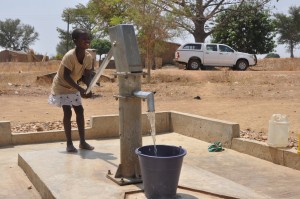Underground water in Bolga said to contain high concentration of flouride
 Mr Nicholas Atubiga, Bongo District Crop Officer, has said underground water in the district contained a high concentration of flouride, thus causing dental fluorosis, a disease of bones and teeth.
Mr Nicholas Atubiga, Bongo District Crop Officer, has said underground water in the district contained a high concentration of flouride, thus causing dental fluorosis, a disease of bones and teeth.
He said the concentration was usually 1.5mg/l and above.
Mr Atubiga said most parts of the district are overlaid by granitic rocks which have fluoride ions in them, and that the excessive amounts of fluoride found in ground water, cause the disease.
Mr Atubiga who made these disclosures at a workshop aimed at helping find ways to accelerate water and sanitation coverage to meet Millennium Development Goal Seven on Water and Sanitation, said the fluoride level had contributed to the water scarcity in the area.
He said other water and sanitation challenges in the district include, successive droughts, huge accumulated water deficit, inefficient usage of irrigated water, large population increase, and pollution of ground and surface water, and added that these are major issues affecting the people.
He said about 80 per cent of the populace also engage in open defecation, thereby pollution the water bodies.
He said the district also has few public places of convenience, made up five Septic Tank Latrines, six KVIP Latrines, one Environloo, nine urinals, 110 house-hold water closets, 874 VIPs, and 87 institutional latrines.
Mr Atubiga pointed out that poor sanitation has direct impact on water sources, including pollution of water bodies, unpleasant odour and water turbidity, while the aesthetic beauty of the environment is affected adversely, leading to water and sanitation related diseases.
The Water Resources Commission (WRC), in collaboration with Global Water Partnership (GWP), organized the workshop, which formed part of the accelerating sanitation and water for all in Ghana project, being undertaken by WRC with sponsorhip from UNICEF, and supported by the Netherlands government.
Stakeholders who attended the workshop included representative of district assembles, the Ministries, Department and Agencies, and non-governmental organiaztions in the Upper East Region.
The project is being carried out in five regions, namely, Central, Volta, Northern, Upper East and Upper West.
Source: GNA
